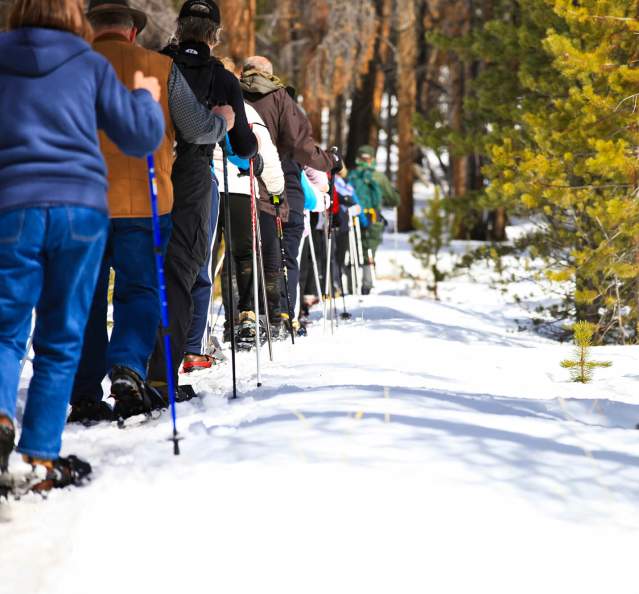Winter & Spring in Rocky Mountain National Park
Winter and spring (which really feels like sunny, milder winter) in Rocky Mountain National Park is a hushed and magical time to visit. Snow blankets the peaks, the roads are silent and free from camper traffic, and the animals ease down into the low meadows surrounding the Colorado River to weather the long winter.
Although the famous Trail Ridge Road (which crosses the Continental Divide and takes visitors to either side of the park) is closed in winter, plenty of roads remain open to visitors who enter coming from Granby, making it easy to explore.
Snowshoeing and Nordic Skiing
Most trails beloved by summer visitors are still accessible, as long as you’ve got some gear. Snowshoes or sturdy cross-country skis are ideal for exploring the quiet forests and frozen waterfalls throughout the park. If you need snowshoes, you can rent them at Two Pines Supply, located on Main Street in Granby.
Popular winter destinations include Cub Lake and Mills Lake. Coyote Valley Trail is only a mile and offers a very friendly, easy-access introduction for those new to skiing or snowshoeing. It’s also great for moose sightings. Want to go with a guide? In typical years, the park offers regular ranger-led tours throughout the season, and Grand Mountain Guides in Granby offers tours as well.
Before heading out, make sure to check the weather and avalanche conditions. Dress in warm layers, wear waterproof boots, and bring a pack with extra food, water, dry socks, sunscreen, and even a fire-starting kit, as conditions can be very changeable. Call the park Information Office for the latest information: (970) 586-1206.
Moose Watching
It’s one thing to see a moose on TV, and another to have one cross your path—probably one of the greatest wildlife bucket-list moments you can experience. The very best place to find moose is in the Kawunceeche Valley near the Colorado River.
You might easily spot them by spotting those who spotted them first—look out for “moose jams,” or cars parked on the side of the road, indicating there’s something big nearby! Moose love the low-lying valleys and wet areas near lakes, including Timber Creek Campground and Lulu City trail.
Other Wildlife Viewing
Winter is a wonderful time to see wildlife, with fewer crowds to scare them off, and many large mammals coming down to the low meadows for the winter. Dawn and dusk are the best times to catch animals like elk and deer, coyotes are easy to spot in snow-covered meadows as they hunt for mice, and brilliant Steller’s and gray jays frequent parking and picnic areas
If you encounter any wildlife, make sure to observe from a distance and do not approach. Also, never feed any wild animals. Ask a ranger when you first enter the park to share information on any recent sightings.
Summer
Summers are short, but oh, so sweet in Rocky Mountain National Park. Here are three ways to enjoy it.
Fall
One of the most stunning times of year to visit Rocky Mountain National Park is the early fall—September through early October. Why? Bluebird skies, snow-dusted peaks, and the heavenly gold of aspen trees as they turn. You’ll...


